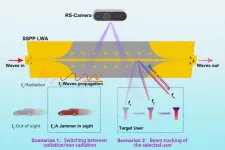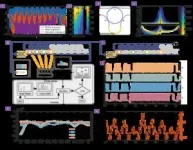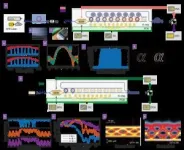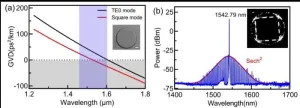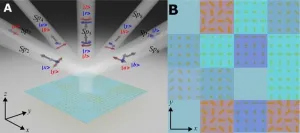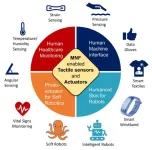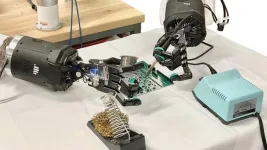A new publication from Opto-Electronic Advances; DOI 10.29026/oea.2024.240040, discusses an externally perceivable smart leaky-wave antenna based on spoof surface plasmon polaritons.
Smart antennas have garnered significant attention for their ability to enable both communication and perception functions simultaneously, commonly with complicated control and high cost though. The growth of the Internet of Things (IoT) and artificial intelligence (AI) has led to new applications across disciplines, and a range of flexible and miniaturized perceptive devices. Therefore, smart antennas that can complete the task of environment perceiving and signal transmitting and receiving in complex wireless channels will play an important role in future communication, sensing and other fields.
The smart antenna is continuously evolving, typically encompassing three main categories: 1. Beamforming antennas: These antennas dynamically adjust their orientation to focus the signal and provide enhanced signal coverage and quality. However, they require complex hardware and signal processing, increasing system costs and posing adaptation challenges in dynamic environments. 2. Adaptive antennas: These antennas adjust their parameters in real-time to improve signal quality and combat interference. Despite their benefits, they demand complex hardware and algorithms, along with significant computing resources. 3. Multi-functional metasurfaces and reconfigurable intelligent surfaces (RIS): multi-functional metasurfaces achieve full-space functions by adjusting the phase or polarization of units, enabling capabilities like holograms and optical sensing. RIS optimize signal channels by adjusting reflection and refraction properties, so as to improve signal coverage and capacity. They require sophisticated control system when the metasurface is large scale.
Among them, metasurfaces combined with sensors have advanced intelligent electromagnetic (EM) control systems. For instance, metasurfaces integrated with computer vision (CV) rely on cameras, data, and algorithms to perform tasks like beam tracking, remote sensing, and traffic surveillance. Intelligent metasurface systems based on CV have been developed for EM tracking and real-time wireless communication with moving targets. These systems tune the EM characteristics of each unit cell in the metasurface electrically, enabling high-accuracy and flexible real-time beamforming. However, manufacturing complexity and power consumption pose technical challenges.
With the goal of developing a new type of smart antenna with reduced system complexity and costs, an externally perceivable leaky-wave antenna (LWA) system based on spoof surface plasmon polaritons (SSPPs). Spoof surface plasmon polaritons (SSPPs) is a special type of "one-dimensional" metasurface with highly localized EM fields and flexible and tunable dispersion properties, which can provide novel solutions for the development of next-generation circuits and systems. Low-crosstalk and conformal transmission lines, active and passive devices and communication systems based on SSPPs have been proposed, with the advantages of miniaturization, conformal, low cost and easy integration for future wireless communication. Among them, SSPP leaky-wave antennas possess flexible control, wide frequency band and high gain, and can realize large angle beam scanning. Compared with metasurface, the reconfigurable SSPP antenna has fewer active components and lower design complexity and is relatively simple to manufacture and low power consumption. In view of this, the reconfigurable SSPP leaky-wave is particularly suitable for the development of smart antenna.
The authors of this article delivered an externally perceivable leaky-wave antenna (LWA) based on SSPPs. The proposed smart SSPP-LWA system with external perceptibility can automatically realize real-time switching between the “radiation” state (when external eavesdropper is not detected) and the “non-radiation” state (when external eavesdropper is detected), as well as beam tracking towards recognized moving target. In the communication scenarios shown in Fig. 1, the SSPP-LWA obtains the real-time location information of the external jammer or target user through CV, switches the radiation/non-radiation states accordingly, and realizes automatic tracking of moving target by adjusting the input frequency. Leveraging the capabilities of beam reconfiguration and external perception, the proposed SSPP-LWA serves as a prime contender for smart systems, offering the ability to autonomously select optimal operating modes and intelligent communication in dynamic, complex environments.
This work is crucial as it addresses several challenges that current smart antenna systems face, such as limited operating bands, high complexity, and substantial costs. It also improves radar systems and secure communication channels through adaptive beamforming and interference mitigation. Additionally, it facilitates efficient and reliable communication between a vast number of devices in smart homes and cities. Enhanced radar, better communication and sensing capabilities can make autonomous vehicles safer and more reliable and enhancing the user experience in everyday applications such as mobile internet and streaming services.
The next steps for this research involve refining the SSPP-LWA technology with other advanced systems, such as unmanned aerial vehicle (UAV) communication networks and artificial intelligence (AI), to enhance its capabilities. Building upon the proposed reconfigurable SSPP-LWA, there is potential to design multi-dimensional digital LWAs in the future. In brief, different radiation states can be determined by amplitude, frequency, and polarization coding matrixes, allowing digital baseband signals to be directly modulated onto the radiated wave. Consequently, the presented reconfigurable SSPP-LWA is expected to find applications in future intelligent wireless communications.
The smart SSPP-LWA system perceives the environment in real time to complete the adaptive working state and accurate target tracking, which can not only optimize the spectrum utilization and reduce interference, but also improve the intelligence level and automation level of the system, showing a wide range of application prospects in the fields of UAV, automatic driving, intelligent transportation and so on.
Keywords: smart antenna / external perception / spoof surface plasmon polaritons / computer vision aids
# # # # # #
The authors of this paper are members of the "Electromagnetic Metamaterials" team at Southeast University, led by Prof. Tie Jun Cui. The team has conducted systematic and in-depth research on electromagnetic metamaterials, focusing on the modeling of electromagnetic scattering characteristics of complex targets and environments. They have pioneered global research in digital metamaterials, information metamaterials, and intelligent metamaterials. Their original contributions include concepts such as the cooperative regulation of electromagnetic waves and digital information, as well as low-cost phase-control technology based on space-time encoded information metamaterials.
The team's innovative research has successfully addressed the challenge of integrating electromagnetic waves with digital information, resulting in a number of groundbreaking technologies in wireless communication, intelligent imaging, and sensing. These advancements have had a significant international impact. The team has been recognized with numerous prestigious awards, including the Second Prize of the National Natural Science Award in both 2014 and 2018, the "National Innovation Award" and the "Frontier of Science Award" at the 2023 International Congress of Basic Science (ICBS), and the Tan Kah Kee Science Award and IEEE Marconi Prize in 2024.
# # # # # #
Opto-Electronic Advances (OEA) is a rapidly growing high-impact, open access, peer reviewed monthly SCI journal with an impact factor of 15.3 (Journal Citation Reports for IF2023). OEA has been indexed in SCI, EI, DOAJ, Scopus, CA and ICI databases, and expanded its Editorial Board to 31 members from 17 countries with an average h-index of 62.
The journal is published by The Institute of Optics and Electronics, Chinese Academy of Sciences, aiming at providing a platform for researchers, academicians, professionals, practitioners, and students to impart and share knowledge in the form of high quality empirical and theoretical research papers covering the topics of optics, photonics and optoelectronics.
# # # # # #
More information: http://www.oejournal.org/oea
Editorial Board: http://www.oejournal.org/oea/editorialboard/list
All issues available in the online archive (http://www.oejournal.org/oea/archive).
Submissions to OEA may be made using ScholarOne (https://mc03.manuscriptcentral.com/oea).
ISSN: 2096-4579
CN: 51-1781/TN
Contact Us: oea@ioe.ac.cn
Twitter: @OptoElectronAdv (https://twitter.com/OptoElectronAdv?lang=en)
WeChat: OE_Journal
# # # # # #
Li WH, Chen J, Gao SZ et al. An externally perceivable smart leaky-wave antenna based on spoof surface plasmon polaritons. Opto-Electron Adv 7, 240040 (2024). doi: 10.29026/oea.2024.240040
END
